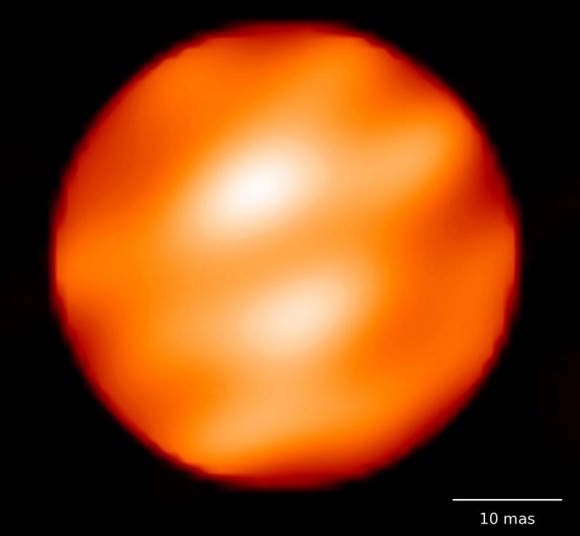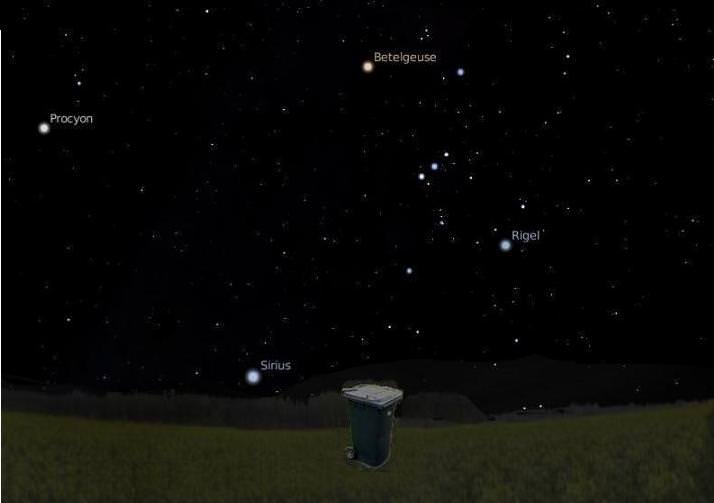Whatever hectic pressures may be at play in your life, you can always look forward to one quiet moment each week to contemplate the night sky in peace. I refer, of course, to when you have to take out the garbage – or as the Americans would have it – the trash.
Bin night observing receives less attention than perhaps it should in the astronomical literature. The chance to check the night sky once a week and at about the same hour gives you a chance to experience the difference between solar and sidereal time since the same stars now rise about 28 minutes earlier they did last week. And of course, you can quickly check the ecliptic for planets and for the Moon’s phase if it’s up.
Rarely, there may also be opportunities for educational outreach. A neighbor, aware of my astronomical tendencies, once asked me whatever happened to the Milky Way, which she recalled seeing as a child. I didn’t consider this a dumb question, since I remember seeing it as a kid too – it really is a ghost of its former self.
We had a useful chat about light pollution and then she said it. What’s that red one? Is it Mars? Not being on the ecliptic, it wasn’t – and the proximity of Orion’s Belt was a bit of a give-away. It’s Betelgeuse, I told her and she remembered the name from a Douglas Adams story and then we said good night. Astronomy advocacy in sixty seconds.

But I hate that color thing. I’ve spent years unsuccessfully squinting to make out the allegedly red color of Mars or the yellowish tinge of Saturn – while as soon as I get someone interested in the night sky they start picking out M type supergiants. I’m not color blind and I manage just fine in the daytime. But bin nights have always been a strictly black and white affair.
That is until now. I saw that Mythbusters episode about how early sailors wore an eye patch so that during a cannon battle they always had one dark-adapted eye. Allegedly, this was so they could go into the powder room for more ammunition without having to light a match.
As you probably know it’s all about the rods and the cones in your retina. The cones carry three types of photopsins – that preferentially absorb red, green and blue, while the rods carry the all important rhodopsin – which enables you to see in very dim light, though just in black and white. Apparently, it takes rhodopsin 30 mins to recover from light bleaching, but only nine minutes for the photopsins. Nine minutes is all I need to decant the kitchen scraps, grab the recyclables and wheel the bins out to the kerb. Then patch off, I can enjoy an opsins-optimized, monocular view of the night sky and yep, there’s a little hint of orangey-red. Awesome.
You should try it. In fact I’d be grateful if everyone would try it and spread the word. So the next time someone in my street asks… Who’s that nut taking out his garbage dressed like a pirate? There’ll be someone nearby to explain… It’s OK. He’s an astronomer.


For some reason I found this funny.
As the Americans have it- TRASH.
Haha.
And of course this post talks about having a moment infront of you garbage bag. XD
Over the last 400 years there has been a positive correlation between the growth of the weekly trash and light pollution….. I don’t think there’s any causality (!) but both are shocking wastes of energy. One is wrecking the night sky, the other is turning the countryside into one massive landfill tip.
Sorry to hijack the thread, but the Mythbusters eyepatch episode pretty much disproved the general usefulness of the supposed practice; and as someone who has done a gob of research about sailors , piracy, and sealore. I never once have heard this supported by any source I consider knowledgable. Not only is binocular depth perception a fine thing, but the division of labour on board a fighting ship reduced the need for crew to be moving between sunlight and dark holds. Look up “Powder-monkey” to see how this was done.
Agreed about the whole light pollution/ trash paradigm.
Haha…totally agree, i always looked up the sky when grab my garbage outside or walking in the university, recently i saw a pin pointer red star “moves”, i don’t know how could i explained it, is just like u saw two red/pink dots on the sky, suddenly one of it can moves and in a quite ‘observable’ speed. That time there was a airplane flying 90degree from it and they get come across. Nothing happened to the plane n no any report about that in local newspaper. So i guess the ‘thing’ is higher then the plane. I’m not trying to relate it to any other things, just i cannot explain what i saw. A satellite will be moving too fast for that, maybe a missile? but it’s just a star looked like the one beside it before it “migrated” n disappear from my view in about 20 seconds??… just sharing my experience.
ciament
Flashing lights in the dark like aeroplane lights can give the illusion of movement, it is very profound and thought to be due to the brain interpreting the flashing as a moving object disappearing behind obstacles. Try it in a friend and ask them to track the movement on a piece of paper, they will have it wansering all over when you don’t move it..
I acknowledge that the use of an eyepatch for naval battle purposes is apocryphal. But for bin-night observations – I’m calling it plausible.
Rubbish!!! As we say in Britain.
Thanks SteveZodiac for your explanation, maybe it’s some kind of special jet i guess, cause it definitely flies higher than than the airplane that come across in the same time. or i was so lucky to see a comet with naked eyes =)
Will it be: “WISE Bags its First Near-Earth Asteroid” (25 Jan) that i saw that nite LOL